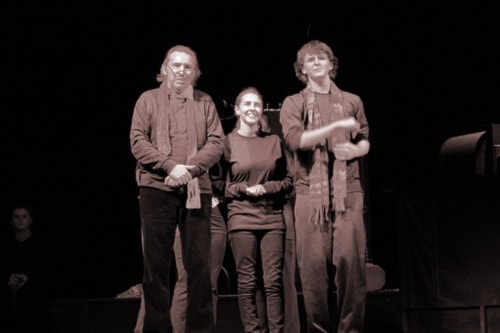Bah, humbug! is how the play started out in the Kaatza Lakeside Players’ 2012 telling of the story of Ebenezer Scrooge.
In just a little over an hour, the Lake Cowichan theatre group presented A Christmas Carol, a radio play adapted and scored for the stage by Anthony E. Palermo, and directed by Dena McPhee.
With a darkened stage, no backdrop or sets, and the actors dressed in black, the production wasn’t aiming at stimulating the visual senses of the audience.
Rather, McPhee said in an earlier interview, she wanted the audience to let their imaginations do the work, going so far as to have audience members close their eyes and listen, as they might do for a real radio play.
Between the on-stage sound effects and Edward Lentz’s interpretation of Scrooge, it was hard to take her advice.
It took three sound effects operators to create all the sounds that helped bring the play to life. There were slamming doors, rattling chains (which could have been louder), the sound of curtains being opened and shut, and the clip-clop of horses’ hooves on cobbled streets in 19th century London, to name a few.
A spirit machine -— operated by Alain Boucher-Hamilton — was intriguing, and with the darkness of the set, it was difficult to see exactly how he was making those eerie sounds. McKenzie Paterson and Lillian Laird were the other two pair of hands that kept the sound props going.
As for Lentz, he really carried the play as far as acting goes. In all fairness, he often had the stage to himself so he had to carry the load, which he did, and the production wouldn’t have been as successful if he hadn’t.
Lentz added just the right amount of physical movement and facial expression to his lines, so that we saw a Scrooge who reacted both vocally and visually to events throughout the play: his initial reaction to having to give his long-suffering employee Bob Cratchit a day off, Jacob Marley’s visit and warning on Christmas Eve, each of the three ghosts that visit him that same night, and the final revelation on Christmas Day when his attitude finally changes to that of a giving nature.
Although a newcomer to the Lakeside Players, Lentz has been involved in amateur theatre for many years with the Shawnigan Lake Players. In many ways, Lentz says his final collaboration with them — he did a monologue play written by his wife — prepared him for taking on this role.
Also to be remarked for his stage presence throughout the play was young Bailey Callihoo, who seems to have a natural flair for acting.
Because this production was done as a radio play, the narrator was instrumental in carrying the story, and Dale Winters’ articulate voice worked well for that. Even though he was on stage, Winters’ voice was miked, which was probably a good move, because it was sometimes difficult to hear other cast members whose voices didn’t project, and it would have been a shame to miss the narration which tied the segments of the story together.
The radio-play experience was a new venture for the Lakeside Players, and one that brought in new elements and challenges for the cast and crew. McPhee and all the volunteers and board members put a lot of effort into making it work for everybody involved, both on stage and for the audience.
